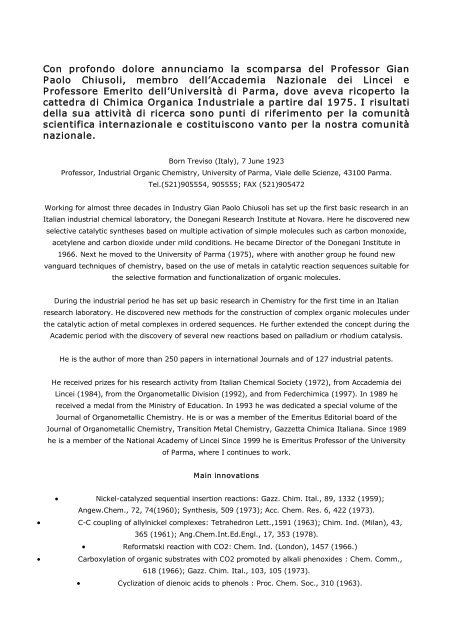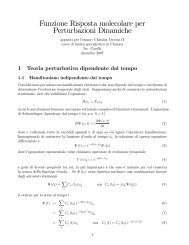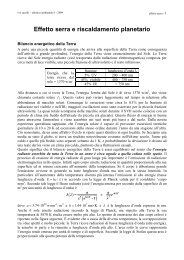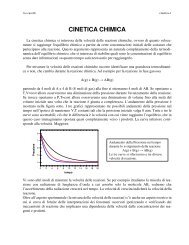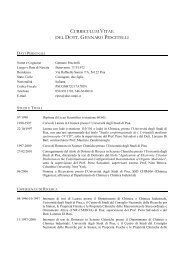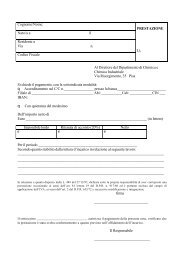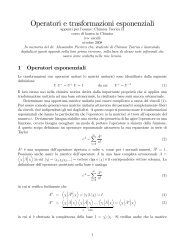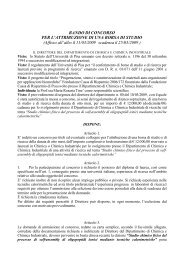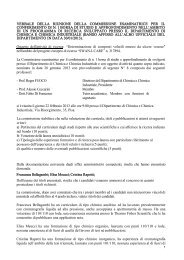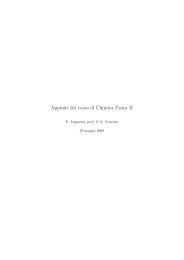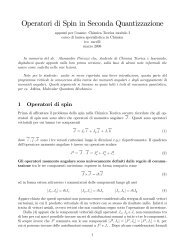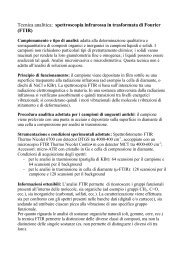Con profondo dolore annunciamo la scomparsa del Professor Gian ...
Con profondo dolore annunciamo la scomparsa del Professor Gian ...
Con profondo dolore annunciamo la scomparsa del Professor Gian ...
You also want an ePaper? Increase the reach of your titles
YUMPU automatically turns print PDFs into web optimized ePapers that Google loves.
<strong>Con</strong> <strong>profondo</strong> <strong>dolore</strong> <strong>annunciamo</strong> <strong>la</strong> <strong>scomparsa</strong> <strong>del</strong> P rofessor <strong>Gian</strong><br />
P aolo Chiusoli, membro <strong>del</strong>l’Accademia Nazionale dei Lincei e<br />
P rofessore Emerito <strong>del</strong>l’Università di P arma, dove aveva ricoperto <strong>la</strong><br />
cattedra di Chimica Organica Industriale a partire dal 1975. I risultati<br />
<strong>del</strong><strong>la</strong> sua attività di ricerca sono punti di riferimento per <strong>la</strong> comunità<br />
scientifica internazionale e costituiscono vanto per <strong>la</strong> nostra comunità<br />
nazionale.<br />
Born Treviso (Italy), 7 June 1923<br />
<strong>Professor</strong>, Industrial Organic Chemistry, University of Parma, Viale <strong>del</strong>le Scienze, 43100 Parma.<br />
Tel.(521)905554, 905555; FAX (521)905472<br />
Working for almost three decades in Industry <strong>Gian</strong> Paolo Chiusoli has set up the first basic research in an<br />
Italian industrial chemical <strong>la</strong>boratory, the Donegani Research Institute at Novara. Here he discovered new<br />
selective catalytic syntheses based on multiple activation of simple molecules such as carbon monoxide,<br />
acetylene and carbon dioxide under mild conditions. He became Director of the Donegani Institute in<br />
1966. Next he moved to the University of Parma (1975), where with another group he found new<br />
vanguard techniques of chemistry, based on the use of metals in catalytic reaction sequences suitable for<br />
the selective formation and functionalization of organic molecules.<br />
During the industrial period he has set up basic research in Chemistry for the first time in an Italian<br />
research <strong>la</strong>boratory. He discovered new methods for the construction of complex organic molecules under<br />
the catalytic action of metal complexes in ordered sequences. He further extended the concept during the<br />
Academic period with the discovery of several new reactions based on pal<strong>la</strong>dium or rhodium catalysis.<br />
He is the author of more than 250 papers in international Journals and of 127 industrial patents.<br />
He received prizes for his research activity from Italian Chemical Society (1972), from Accademia dei<br />
Lincei (1984), from the Organometallic Division (1992), and from Federchimica (1997). In 1989 he<br />
received a medal from the Ministry of Education. In 1993 he was dedicated a special volume of the<br />
Journal of Organometallic Chemistry. He is or was a member of the Emeritus Editorial board of the<br />
Journal of Organometallic Chemistry, Transition Metal Chemistry, Gazzetta Chimica Italiana. Since 1989<br />
he is a member of the National Academy of Lincei Since 1999 he is Emeritus <strong>Professor</strong> of the University<br />
of Parma, where I continues to work.<br />
Main innovations<br />
· Nickelcatalyzed sequential insertion reactions: Gazz. Chim. Ital., 89, 1332 (1959);<br />
Angew.Chem., 72, 74(1960); Synthesis, 509 (1973); Acc. Chem. Res. 6, 422 (1973).<br />
· CC coupling of allylnickel complexes: Tetrahedron Lett.,1591 (1963); Chim. Ind. (Mi<strong>la</strong>n), 43,<br />
365 (1961); Ang.Chem.Int.Ed.Engl., 17, 353 (1978).<br />
· Reformatski reaction with CO2: Chem. Ind. (London), 1457 (1966.)<br />
· Carboxy<strong>la</strong>tion of organic substrates with CO2 promoted by alkali phenoxides : Chem. Comm.,<br />
618 (1966); Gazz. Chim. Ital., 103, 105 (1973).<br />
· Cyclization of dienoic acids to phenols : Proc. Chem. Soc., 310 (1963).
· Oxidative carbony<strong>la</strong>tion of acetylene : Chem. Ind. (London), 977 (1968).<br />
· Coupling of acrylonitrile to adiponitrile on cobalt(0): Chem. Comm., 1515 (1968).<br />
· Asymmetric carbony<strong>la</strong>tion of styrene at room temperature and atmospheric pressure: J.<br />
Organomet. Chem., 236, C31 (1982)).<br />
· Che<strong>la</strong>tionassisted reactions Rearrangement of allyl 3butenoate :J.C.S.Chem.Comm., 793<br />
(1977); J. Mol. Cat., 41, 75 (1987)); J. Chem. Soc. Perkin Trans. 1, 1347 (1994)).<br />
· Ary<strong>la</strong>tion via aroyl chlorides: Trans. Metal Chem., 4,398 (1979)).<br />
· Multiple insertions terminated by H (de<strong>la</strong>yed hydrogenolysis): J. Organomet. Chem., 199, C21<br />
(1980)).<br />
· Oxidative carbony<strong>la</strong>tion of styrene : J. Organomet. Chem., 181, C14 (1979).<br />
· Catalysis by pal<strong>la</strong>dium(0) of catalysis of diene addition to double bonds by rhodium(I): J. Chem.<br />
Soc. Chem. Comm.,1303 (1990)).<br />
· Metal<strong>la</strong>cyclepromoted reactions. Cobalt(0) metal<strong>la</strong>cycles as catalysts: J. Chem. Soc. Chem.<br />
Comm., 1632 (1990))<br />
· Metal<strong>la</strong>cycle promoted reactions. Aromatic and alifatic CH activation (first paper: J. Organomet.<br />
Chem., 233, C21 (1982); Pure Appl. Chem., 62, 623 (1990)).<br />
· Pal<strong>la</strong>dium(IV) metal<strong>la</strong>cycles: J. Organomet. Chem., 346, C27 (1988); Gazz. Chim. Ital., 123, 1<br />
(1993)).<br />
· Synthesis of pyrrolediacetic acid by oxidative rbony<strong>la</strong>tion : Synthesis, 262 (1989).<br />
· Combination of pal<strong>la</strong>diumcatalyzed oxidative carbony<strong>la</strong>tion with reduction in a single process: J.<br />
Chem. Soc. Chem. Comm., 2429 (1994).<br />
· Carbony<strong>la</strong>tion of alkynes to beta<strong>la</strong>ctones and <strong>la</strong>ctams: J. Chem. Soc. Chem. Comm., 1429<br />
(1994); Tetrahedron Lett. 36, 7495 (1995)).<br />
· Pal<strong>la</strong>diumcatalyzed multicomponent reactions to form heterocyclic rings: J. Organomet. Chem.,<br />
371, C51 (1989); Tetrahedron Lett., 35, 5919,5923 (1994).<br />
· Direct incorporation of carbon dioxide into amines: J. Chem. Soc.Chem. Comm. 16691700<br />
(1999); J. Chem Soc Perkin Trans. 15411546 (1998).<br />
· Sequential reactions of carbon monoxide and carbon dioxide: Chem. Comm. 13811382 (1999);<br />
J. Mol. Cat. A Chemical 143, 297310 (1999).<br />
· Catalytic carboncarbon coupling through CH activation: Coord. Chem. Rev. 254, 456459<br />
(2010).<br />
The problem of Darwinian evolution in Chemistry has been examined recently: Rend. Fis. Acc. Lincei 20,<br />
199209 (2009)<br />
Chiusoli also coedited with Peter Maitlis a book on Metalcatalysis in Industrial Organic Processes<br />
published by RSC in 2006 and 2008


